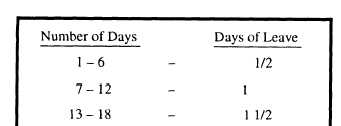| |
Figure 1-4.—Leave computation.
MILPERSMAN, Article 3020160, contains specific
instructions on leave accounting. Leave is computed as
follows:
Leave is credited at the rate of 2 1/2 days for each
full month on active service and at the rates provided in
figure 1-4 for fractional parts of a month.
Leave is not creditable for any period when the
member is in a lost time, excess leave, or other nonpay
status. Leave earnings are reduced for each
noncreditable period using figure 1-4.
When leave is computed at the end of a period of
active service for the purpose of making cash settlement
and the final leave balance includes a half-day total, the
total should not be advanced to the next higher full day.
The amount to be paid should be computed by crediting
the member with one-half of a day’s entitlement. The
total amount should be rounded to the nearest penny. If
a minus leave balance includes a half-day total, the
minus balance is increased to the next highest full day.
Determine leave between permanent change of
stations (delay in reporting [DELREP]) as follows.
Working backward, compute the number of days’ travel,
proceed, and leave according to the MILPERSMAN,
Articles 1810300, 1810320, and 1810360. When both
travel in and out of the CONUS are involved, the
allowable travel time (INCONUS and OUTCONUS) is
added. The number of days remaining, after deducting
the proceed time and travel time from the elapsed time,
is chargeable as leave. The number of days computed as
leave, proceed time, and travel time is constructively
charged in that order.
GRANTING LEAVE AND LEAVE
SCHEDULES
Officers authorized to grant leave should establish
and regulate schedules to provide for maximum use of
earned leave. Of course, it must be consistent with
operational and training workloads, the maintenance of
the required degree of operational readiness, and the
desires of the individual members. All personnel should
be provided the time to take their 30 days’ leave each
year.
COs establish annual leave programs for their units
to provide opportunity for all personnel to take leave.
This must be done within the constraints of operational
military requirements and the degree of support for
leave provided in the unit manning document.
In addition to your activity’s leave tickler file, you
should develop a local leave schedule or chart to help
you monitor and track your personnel on leave.
The leave schedule or chart should be maintained
and updated periodically to help you manage your
personnel. Refer to the MILPERSMAN, Articles
3020020 through 3020200, SECNAVINST 7020.63D,
and SECNAVINST 7220.81 for more information
concerning leave.
DEPARTMENTAL WORK
COORDINATION AND PROFESSIONAL
RELATIONSHIPS
Working closely with other departments requires
that you maintain a close and professional relationship
with various personnel within the department. A good
relationship with other departments will help you carry
out your job with less effort. Set up contacts and
maintain a harmonious relationship with others and the
benefits will be mutual.
You also must have a good working relationship
with your own co-workers and superiors. In particular,
you must support the decisions of your division chief
and your division officer. Remember that a link must
exist between you and the chain of command. Your
division chief and division officer are your link to the
rest of the chain of command.
If disagreements exist between you and your
superiors, the best thing to do is to talk with them. Your
superiors may not know or understand that a problem
exists. Resolve the problem by discussing the issues
with them and come up with a mutual understanding.
If your discussion does not solve the problem, get
other people involved, like the command master chief.
He or she can help you solve many of the problems you
may encounter. Also remember your job is to support
the chain of command.
1-18
|


